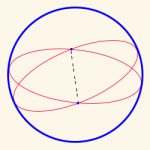Have you had your caffeine injection yet? Well, then, here are three puzzles (with answers, but the answers are not helpful!):
 Can you completely mix a mug of coffee, such that, at every point inside the mug, the coffee at that point is different after stirring from before stirring? Go get a cup of joe (or tea), stir it, and see what you think.
Can you completely mix a mug of coffee, such that, at every point inside the mug, the coffee at that point is different after stirring from before stirring? Go get a cup of joe (or tea), stir it, and see what you think.
Answer: no. There will always be at least one point that is the same after the liquid has settled, no matter how vigorously you stir it. It is mathematically impossible for there to be no such points inside the mug.- Do there exist on the surface of the Earth, at any given time, two antipodal points that have exactly the same surface temperature?
Answer: yes. What about two antipodal points that have exactly the same barometric pressure? Also yes. Two antipodal points that have exactly the same surface temperature and exactly the same barometric pressure? Yet again, yes. This is mathematically inescapable.
 At any time there exists a continuous curve on the Earth’s surface on which every point has an antipodal point that also lies on the curve and that has the same temperature. There is a different continuous curve on which antipodal points have the same pressure. And the two curves must intersect, since both encircle the globe, each separating it into two pieces. So that means there must be, at any time, at least one pair of antipodal points somewhere on the surface of the Earth that have the same temperature and the same pressure.
At any time there exists a continuous curve on the Earth’s surface on which every point has an antipodal point that also lies on the curve and that has the same temperature. There is a different continuous curve on which antipodal points have the same pressure. And the two curves must intersect, since both encircle the globe, each separating it into two pieces. So that means there must be, at any time, at least one pair of antipodal points somewhere on the surface of the Earth that have the same temperature and the same pressure.
You’ve probably surmised by now—you drank that cup of joe, right?—that this is true not just for temperature and pressure but for any two continuously variable parameters (such as temperature, pressure, humidity, wind speed, solar and terrestrial radiation, cloud ceiling, particulate density, atmospheric composition, and so on). You would be correct. - Think of a multi-digit positive integer. Any such number will do—for example, $76.$ Now add up its digits and subtract that sum from the original number. $76\,- (7+6) = 63.$ Now apply this algorithm to the new number: $63\,- (6+3) = 54.$ Keep doing this until the resulting number has shrunk to just one digit. $54\,- (5+4) = 45$, $\dots, 18\,- (1+8) = 9.$
Ta da! (Yes, really.) No matter your starting number (as long as it has more than one digit), you will always end up at $9$.
Here is a quick and dirty python program that performs this task for any positive integer, returning the end result (which had better be nine!) and the number of iterations it took to get there:
def digi9(n): count = 0 while True: k = sum(list(map(int,','.join(str(n)).split(',')))) m = n - k if len(str(m)) == 1: return m, count+1 n = m count += 1Let’s consider an example:
>>> digi9(72459075) (9,2191634)
Starting with the randomly chosen number $72,459,075$, over two million iterations later we indeed end at $\dots, 27\,-(2+7) = 18,$ $18\,- (1+8) = 9.$
How are the answers to these little puzzles so? Welcome to the world of fixed point theorems! In mathematics, a fixed point is a member of a set such that an operation on the set at that point maps back to the point. The set can be anything—the set of integers, a Euclidean line, surface, or volume, etc. This concept has wide application and profound consequences in many branches of mathematics. The above puzzles are examples of fixed points in their respective sets. Put that in your mug and stir it!
Now go get some more coffee.
Show Me!
Suppose we have a function $f(x)$ such that $f(x) \in [a,b]~~\forall~x \in [a,b]$. That is, the function maps back to its domain. Then $f(x)$ has a fixed point $f(c) = c$ somewhere in the closed interval $a \le c \le b$.
Why? Well, it must be true that
\begin{equation}f(a) \ge a~~~ \mathrm{and} ~~~f(b) \le b \label{condition}\end{equation}
The intermediate value theorem says that if a function $f(x)$ is continuous on a closed interval $[a,b]$, then, for a given $c$ such that $f(a) \le c \le f(b)$, there must exist at least one value $x_0 \in [a,b]$ such that $f(x_0) = c.$
Since the range of our function is restricted to its domain, $f([a,b]) \in [a,b]$, we have from eq. \eqref{condition} that $f(a)-a \ge 0$ and $f(b)-b \le 0.$ If we define $g(x) \equiv f(x)-x$, this is $g(a) \ge 0 \ge g(b).$ By the intermediate value theorem there must then exist a value $c \in [a,b]$ such that $g(c) = 0$. Hence, there must exist at least one fixed point, $f(c) = c.$
This—or, rather, its generalization to any Euclidean space—is essentially a statement of the Brouwer fixed point theorem:
Every continuous function from a closed ball of a Euclidean space into itself has a fixed point.
Legend has it that Brouwer was lead to his theorem by pondering the surface of a cup of coffee upon stirring in a lump of sugar. (That someone would debase a good cup of coffee with sugar is a wholly different issue.)
Vsauce has an interesting video about fixed points, from which I stole the three examples above:
